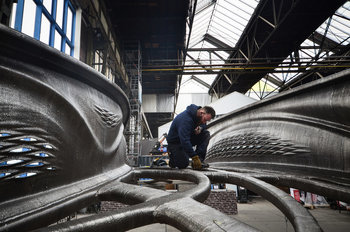

Idea Stage
Generating ideas, building them out and filtering them down to your best ideas. Results in a business plan or business case.
Market Research
Cultivating knowledge of customer needs, perceptions, competition, technology and industry trends.Creativity of Constraints
Early stage constraints designed to direct your efforts. Well designed constraints may stimulate creativity.Preserving Ambiguity
Avoiding assumptions that aren't in your constraints. For example, if you're developing a bicycle, don't assume it has two wheels.Idea Generation
Generating as many ideas as possible. Include everyone in your organization.Creative Processes
Techniques for generating creative ideas such as brainstorming, divergent thinking, thought experiments and counterfactual thinking.Lead Users
Customers who are pushing your products to their limits are a common source of innovative ideas. They often have pain points that identify fundamental flaws in the way that things are done.Market Fit
Estimate the value of ideas in terms of market fit including factors such as customer needs and competition.Risk Management
Identify the risks that surround your ideas. Risks are fully managed though each stage of the innovation process. Risk management is a potent tool for innovation as it is the firms that are taking the biggest risks that benefit most from risk treatment.Idea Screening
Eliminate or backlog as many ideas as possible such that you are left with your best ideas. Associated techniques include reverse brainstorming, defensive pessimism and prioritization.Business Case
Begin the process of documenting your best ideas as a business case or business plan.Testing & Planning
Brave ideas need a significant amount of verification because they are often flawed. Innovation processes are based on lightweight experimentation that explores ideas to find those that are most valuable to your goals.
Concept Testing
Testing high level ideas. For example, a paper prototype for architecture that explores a concept for the form of a building.Test Marketing
Getting something in front of customers as early as possible to collect qualitative data. For example, a poster for a product idea.Business Experiments
Designing experiments that will generate data with techniques such as A/B testing. For example, simulate a manufacturing process to benchmark its estimated performance.Feasibility Study
Research and experiments designed to validate that aspects of an idea are feasible in terms such as cost, time, technology, resources and regulations.Prototypes
Build partial implementations to support testing and planning.Problem Solving
The process of resolving problems identified in testing to build ideas out.Fail Often
One of the key differences between innovation and regular development projects is that innovation expects a large percentage of early stage ideas to fail. Innovation avoids forcing ideas that show little promise. An innovation process might see more than 99% of ideas fail at an early stage.Goals & Objectives
Developing goals and objectives for ideas that survive testing.Strategy
Developing strategies to achieve goals and objectives.Planning
Planning the implementation of strategy. This involves completing a business case, documenting requirements and project management processes.Design & Development
Innovation is often based on the design prowess of a team. A creative director who has launched dozens of unusually valuable products may drive innovation for a firm. In terms of development, innovation is usually about prioritizing work to develop and operationalize small chunks of functionality on a weekly or monthly basis.
Creative Direction
It is common for innovation to fall under a creative director for design and implementation. Generally speaking, innovation requires creative talent and can't be easily systematized.Parallel Design
Creating multiple designs for the same thing in a competitive fashion.Iterative Design
Designing things, using them and designing them again.Transition Design
Innovation is often a bold vision that can't be implemented all at once. Transition design is used to identify meaningful and achievable steps that pull off large changes that would be impossible all at once.Charrette
An intensive group process of delivering design work.Backlog
A backlog of requirements to be implemented in future. It is common for a backlog to grow large with no expectation that all the work will ever be completed. The backlog is allowed to grow at any time and is prioritized with each design and development cycle.Sprints
A short development cycle that creates working items that can potentially be operationalized.Minimum Viable Product
The minimum set of functions and features that allow you to get the product in front of customers.Quality Assurance
The end-to-end process of achieving the target level of quality in products and services. This includes processes such as testing and quality control.Ship Often
Getting things out so that they can be rapidly improved.Marketing & Launch
The process of generating demand and launching products and services.
Target Market
Identifying your customers. If an innovation is disruptive in the sense that it requires customers to change their ways, it will be hard to sell. In this case, a target market will typically be early adopters such as enthusiasts of your product category.Branding
The process of developing brand identity and brand awareness.Promotion
Demand generation using communication processes such as public relations, advertising, events, relationship marketing and strategies to spark word of mouth.Distribution
Methods of selling and delivering a product or service.Pricing
Pricing models and strategy.Market Penetration
The process of gaining market share for a new business, brand, product or service. For example, promotional pricing and free trials. In some cases, market penetration requires skilled personal selling.Pilot
Launching an innovation on a limited basis to manage risk, gain experience and collect data.Moment of Truth
A customer interaction that is predictive of the success of a product or service. For example, audience reactions to the screening of a film.Feedback Loop
Establishing ways to collect data from customers. For example, a firm that knows the top five customer pain points with a new product within a week of launch.Launch
The full commercial launch of an innovation.Operations & Management
The day-to-day process of managing innovative products, services, experiences, processes and environments.
Sales
Reaching your target market to sell a product or service. Includes managing customer relationships and related processes such as voice of the customer.Operations
The process of delivering a product, service, process or experience.Innovation Metrics
Business metrics that are relevant to innovation such as time to volume.Innovation Management
A fully scaled innovation process may have all of the steps above running in parallel at all times. Innovation management is the practice of directing and controlling the innovation process.Product Management
The regular process of managing a product such as monitoring competitive threats, pricing and positioning.| Overview: Innovation Process | ||
Type | ||
Definition | The process of aggressive idea generation, experimentation, design, development, marketing and operations designed to produce valuable innovation. | |
Related Concepts | ||






































